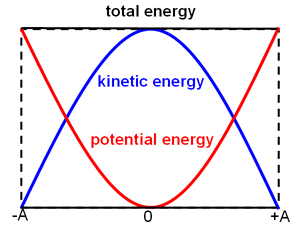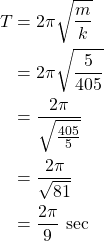Physics - Classical Mechanics - Simple Harmonic Motion Exercises

[Image1]
Introduction
Hey it's a me again @drifter1!
Today we continue with Physics, and more specifically the branch of "Classical Mechanics" in order to get into Simple Harmonic Motion Exercises.
This is also my last post for the year! So, I'm wishing you all happiness and most importantly good health in 2022!
So, without further ado, let's get straight into it!
Example 1: Horizontal Oscillator
Let's consider the horizontal mass-spring system shown in the figure below, where the mass is m = 6 Kg and the spring constant is k = 150 N / m.

Calculate the:
- amplitude (A)
- phase angle (φ)
- total energy (E)
- displacement as a function of time ( x(t) )
for the cases below:

Angular Frequency (ω)
The amplitude (which is needed for most of the variables) can be calculated from the initial velocity v0 and displacement x0, as well as the angular frequency ω, which for now is unknown. So, let's first calculate the angular frequency, as it's the same for all the cases!
In this horizontal spring-mass oscillator the period is :

And thus the angular frequency is given by:

Substituting the known variables gives us:

which is a valid value for all the individual cases!
a) x0 = 0 m, v0 = 10 m/sec
As we covered in a previous part, amplitude can be calculated from the following equation:

Substituting the known values gives us:

From the Reference Circle, because the initial displacement is 0, the phase angle φ will have to be either π / 2 or 3π / 2. But, the initial velocity is positive, and thus we know that the second is true, meaning:

Which is a phase close to the start of the next period. We could also say something like φ = -π / 2 to make it more clear.
Because the initial velocity is also the maximum velocity, the total (or maximum) energy is equal to the kinetic energy at t = 0, which is:

Of course, the same result can also be calculated from potential energy with x = A, which will be the quicker way in the remaining two cases!
Now that everything is known, we can also write the displacement as a function of time:

b) x0 = 0.3 m, v0 = 3 m/sec
Using the same equation as previously, we can calculate the amplitude for the second case now:

The maximum energy can now be calculated from potential energy:

The phase angle is still unknown though, so let's try to calculate it from the displacement equation, which is:

"Plugging in" the known initial value for t = 0, will now give us the phase angle:

Thus, the displacement equation is:

c) x0 = -0.2 m, v0 = 5 m/sec
Now for the last case...
First of all, the amplitude is equal to:

The corresponding total energy is now:

Using the same strategy as in the previous case, the phase angle is:

And so the displacement as a function if time can be written as:

Example 2: Vertical Oscillator
Let's next consider the vertical mass-spring system shown in the figure below, where the mass is m = 5 Kg and the spring constant is k = 405 N / m. The gravitational acceleration is g = 9.8 m / sec 2.

Let's calculate:
- the stretching of the spring (Δl) when the system is at rest
- the period (T) if the system is put into oscillation
- the displacement as a function of time ( y(t) )
For the last one consider only the case:

Spring Stretching at Rest (Δl)
The first problem is a quite simple Equilibrium case. Only two forces act upon the object, which are the gravity and the spring's return force. The system is at rest when those two forces are equal. Thus, we have:

Substituting the known values, gives us the spring's stretching:

Oscillation Period (T)
The period is given by the same equation, independent of the spring's orientation! Basically, the spring's return force is larger when the object moves up, and smaller when the object moves down.
Anyway, the period is:

Displacement as a Function of Time ( y(t) )
In order to calculate the displacement we first need to know the amplitude. The amplitude equation requires the angular frequency, so let's first calculate ω:

And so, the amplitude is:

From the previous example, we know that the phase angle is φ = 3 π / 2 or -π / 2, when the velocity is maximum positive and the displacment is zero. Let's use the second value this time!
So, at last, the displacement as a function of time is:

RESOURCES:
Images
Mathematical equations used in this article, where made using quicklatex.
Block diagrams and other visualizations were made using draw.io.
Previous articles of the series
Rectlinear motion
- Velocity and acceleration in a rectlinear motion -> velocity, acceleration and averages of those
- Rectlinear motion with constant acceleration and free falling -> const acceleration motion and free fall
- Rectlinear motion with variable acceleration and velocity relativity -> integrations to calculate pos and velocity, relative velocity
- Rectlinear motion exercises -> examples and tasks in rectlinear motion
Plane motion
- Position, velocity and acceleration vectors in a plane motion -> position, velocity and acceleration in plane motion
- Projectile motion as a plane motion -> missile/bullet motion as a plane motion
- Smooth Circular motion -> smooth circular motion theory
- Plane motion exercises -> examples and tasks in plane motions
Newton's laws and Applications
- Force and Newton's first law -> force, 1st law
- Mass and Newton's second law -> mass, 2nd law
- Newton's 3rd law and mass vs weight -> mass vs weight, 3rd law, friction
- Applying Newton's Laws -> free-body diagram, point equilibrium and 2nd law applications
- Contact forces and friction -> contact force, friction
- Dynamics of Circular motion -> circular motion dynamics, applications
- Object equilibrium and 2nd law application examples -> examples of object equilibrium and 2nd law applications
- Contact force and friction examples -> exercises in force and friction
- Circular dynamic and vertical circle motion examples -> exercises in circular dynamics
- Advanced Newton law examples -> advanced (more difficult) exercises
Work and Energy
- Work and Kinetic Energy -> Definition of Work, Work by a constant and variable Force, Work and Kinetic Energy, Power, Exercises
- Conservative and Non-Conservative Forces -> Conservation of Energy, Conservative and Non-Conservative Forces and Fields, Calculations and Exercises
- Potential and Mechanical Energy -> Gravitational and Elastic Potential Energy, Conservation of Mechanical Energy, Problem Solving Strategy & Tips
- Force and Potential Energy -> Force as Energy Derivative (1-dim) and Gradient (3-dim)
- Potential Energy Diagrams -> Energy Diagram Interpretation, Steps and Example
- Internal Energy and Work -> Internal Energy, Internal Work
Momentum and Impulse
- Conservation of Momentum -> Momentum, Conservation of Momentum
- Elastic and Inelastic Collisions -> Collision, Elastic Collision, Inelastic Collision
- Collision Examples -> Various Elastic and Inelastic Collision Examples
- Impulse -> Impulse with Example
- Motion of the Center of Mass -> Center of Mass, Motion analysis with examples
- Explaining the Physics behind Rocket Propulsion -> Required Background, Rocket Propulsion Analysis
Angular Motion
- Angular motion basics -> Angular position, velocity and acceleration
- Rotation with constant angular acceleration -> Constant angular acceleration, Example
- Rotational Kinetic Energy & Moment of Inertia -> Rotational kinetic energy, Moment of Inertia
- Parallel Axis Theorem -> Parallel axis theorem with example
- Torque and Angular Acceleration -> Torque, Relation to Angular Acceleration, Example
- Rotation about a moving axis (Rolling motion) -> Fixed and moving axis rotation
- Work and Power in Angular Motion -> Work, Work-Energy Theorem, Power
- Angular Momentum -> Angular Momentum and its conservation
- Explaining the Physics behind Mechanical Gyroscopes -> What they are, History, How they work (Precession, Mathematical Analysis) Difference to Accelerometers
- Exercises around Angular motion -> Angular motion examples
Equilibrium and Elasticity
- Rigid Body Equilibrium -> Equilibrium Conditions of Rigid Bodies, Center of Gravity, Solving Equilibrium Problems
- Force Couple System -> Force Couple System, Example
- Tensile Stress and Strain -> Tensile Stress, Tensile Strain, Young's Modulus, Poisson's Ratio
- Volumetric Stress and Strain -> Volumetric Stress, Volumetric Strain, Bulk's Modulus of Elasticity, Compressibility
- Cross-Sectional Stress and Strain -> Shear Stress, Shear Strain, Shear Modulus
- Elasticity and Plasticity of Common Materials -> Elasticity, Plasticity, Stress-Strain Diagram, Fracture, Common Materials
- Rigid Body Equilibrium Exercises -> Center of Gravity Calculation, Equilibrium Problems
- Exercises on Elasticity and Plasticity -> Young Modulus, Bulk Modulus and Shear Modulus Examples
Gravity
- Newton's Law of Gravitation -> Newton's Law of Gravity, Gravitational Constant G
- Weight: The Force of Gravity -> Weight, Gravitational Acceleration, Gravity on Earth and Planets of the Solar System
- Gravitational Fields -> Gravitational Field Mathematics and Visualization
- Gravitational Potential Energy -> Gravitational Potential Energy, Potential and Escape Velocity
- Exercises around Newtonian Gravity (part 1) -> Examples on the Universal Law of Gravitation
- Exercises around Newtonian Gravity (part2) -> Examples on Gravitational Fields and Potential Energy
- Explaining the Physics behind Satellite Motion -> The Circular Motion of Satellites
- Kepler's Laws of Planetary Motion -> Kepler's Story, Elliptical Orbits, Kepler's Laws
- Spherical Mass Distributions -> Spherical Mass Distribution, Gravity Outside and Within a Spherical Shell, Simple Examples
- Earth's Rotation and its Effect on Gravity -> Gravity on Earth, Apparent Weight
- Black Holes and Schwarzschild Radius -> Black Holes (Creation, Types, How To "See" Them), Schwarzschild Radius
Periodic Motion
- Periodic Motion Fundamentals -> Fundamentals (Period, Frequency, Angular Frequency, Return Force, Acceleration, Velocity, Amplitude), Simple Harmonic Motion, Example
- Energy in Simple Harmonic Motion -> Forms of Energy in SHM (Potential, Kinetic, Total and Maximum Energy, Maximum Velocity), Simple Example
- Simple Harmonic Motion Equations -> SHM Equations (Displacement, Velocity, Acceleration, Phase Angle, Amplitude)
- Simple Harmonic Motion and Reference Circle -> SHM and Smooth Circular Motion, Reference Circle
Final words | Next up
And this is actually it for today's post!
Next time we will cover Simple Pendulums...
See ya!

Keep on drifting!
Posted with STEMGeeks